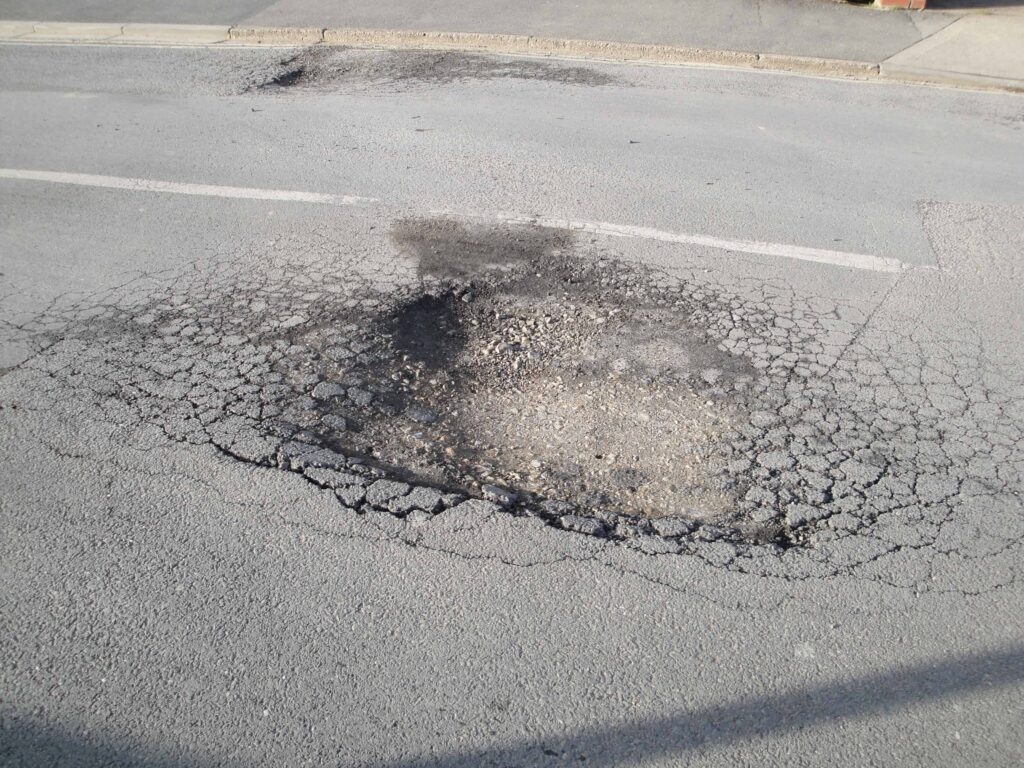 Crews have filled an estimated 108,000 Chicago potholes this winter, in what city and state officials have called a “normal” pothole season. However, recent reporting by the Chicago Tribune suggests that the city may still be falling short in dealing with these hidden pitfalls, putting the public at risk for injury.
Crews have filled an estimated 108,000 Chicago potholes this winter, in what city and state officials have called a “normal” pothole season. However, recent reporting by the Chicago Tribune suggests that the city may still be falling short in dealing with these hidden pitfalls, putting the public at risk for injury.
108,000 Chicago Potholes – and Counting
Crews working for the Chicago Department of Transportation (CDOT) have filled approximately 108,000 potholes – and counting – within the city limits in the first two months of 2018. According to CDOT, the number of Chicago potholes filled is lower than the count of 126,325 for the same time period in 2017.
CDOT Deputy Commissioner Tom Carney suggested that it has not been “that vicious a pothole season,” with a relatively dry, mild December and January. Though the city subsequently experienced snowstorms and rain, causing damage to the roads, the number of Chicago potholes requiring filling has continued to trail behind the previous year’s number. CDOT spokesperson Michael Claffey suggested that repair requests are down because the roads are simply in better condition.
“We’re finding fewer potholes to fill and we’re filling them,” said Mr. Claffey. He claimed that Chicago potholes are filled within three days of a complaint.
In addressing what he feels is the department’s record of success, CDOT Deputy Commissioner Carney cited the advantages of a new labor agreement with greater flexibility that allows CDOT to reassign laborers from other divisions to fix Chicago potholes. If there is a spike in complaints, CDOT may temporarily direct workers who are laying concrete or hanging street signs, for example, to fill potholes.
“But They Hadn’t Done Anything”
Mr. Carney said that residents who find Chicago potholes should report them by phone at 311 or online at the CDOT’s website, giving the department as accurate an address as possible.
But will contacting CDOT actually solve the problem? And what happens when a different department is involved? For at least one Avondale resident, this has been a source of significant and ongoing frustration.
In the autumn of 2017, Chelsea Brown, a 28-year-old yoga instructor, stepped off the curb outside of her home near the intersection of Fletcher Street and Richmond Street – and directly into a deep pothole that was concealed by leaves. “I went straight down,” said Ms. Brown, who scraped her leg as a result of the incident.
Ms. Brown called 311 to report the problem but, as of the beginning of March, no city workers have come to fix the pothole. Since she first alerted CDOT, the pothole has only continued to get bigger, so much so that a neighbor has placed an orange cone in it to warn passersby.
Frustrated by the lack of response from the city, Ms. Brown called 311 again at the end of January or the beginning of February. The only result? A form letter from Mayor Rahm Emanuel and Transportation Commissioner Rebekah Scheinfeld, complimenting her on her civic pride and informing her that CDOT had completed her request.
“They were pleased with themselves about it, but they hadn’t done anything,” said Ms. Brown, who noted that she first read the letter while looking directly at the pothole from her front stoop.
CDOT or DWM? The Difference Is Critical
When pressed on this matter, Mr. Carney pointed out that Chicago potholes are sometimes caused by sewer system problems below the street. This is especially likely with very deep potholes – those that are deeper than 6 or 7 inches – which are usually the result of cave-ins related to water infrastructure. These types of Chicago potholes are classified as “WM (water management) sewer cave-in inspection transfer,” and they are referred to the Department of Water Management (DWM) for resolution.
Mr. Carney suggested that this was likely what happened with Ms. Brown’s pothole, with CDOT closing out the issue on its end after the transfer and sending her the inaccurate form letter. “It’s not what we want to happen,” he said.
According to city data, 31 complaints about Chicago potholes have been referred to the Department of Water Management this year. A DWM spokesperson said that sewer structure failures are largely the result of age and the amount of flow to the structure over time. For this reason, the repair and relining of sewer structures is a key component of the “Building a New Chicago” infrastructure program being implemented by the city.
Dangers of Chicago Potholes
Despite the city’s efforts to repair them, Chicago potholes remain a widespread problem. Potholes can form quickly, and they can easily be hidden by leaves, snow, mud, or debris. As a result, Chicagoans may be unprepared when they encounter potholes, even on streets on which they commute every day.
At best, Chicago potholes are a nuisance, since even smaller ones can seriously damage a motor vehicle. In the worst case scenarios, however, Chicago potholes present a significant public safety risk, causing accidents that can severely injure anyone involved.
Chicago potholes can be dangerous to drivers, motorcyclists, bicyclists, pedestrians, and road workers. Some common types of pothole accidents include the following:
- A wheel becomes lodged in the pothole, causing a car to veer sideways or a bicycle or a motorcycle to flip over.
- A driver sees a pothole at the last second and swerves to avoid it, possibly colliding with another vehicle or a pedestrian.
- A pedestrian or a road worker accidentally steps into or trips over a pothole, resulting in a fracture or a severe sprain.
Chicago Personal Injury Lawyers
If you have been wrongfully injured, whether because of Chicago potholes or in some other way, please contact GWC today for a free consultation with one of our Chicago personal injury lawyers. Call our office at (312) 464-1234 or click here to chat with one of our representatives.
<< BACK TO BLOG POSTS